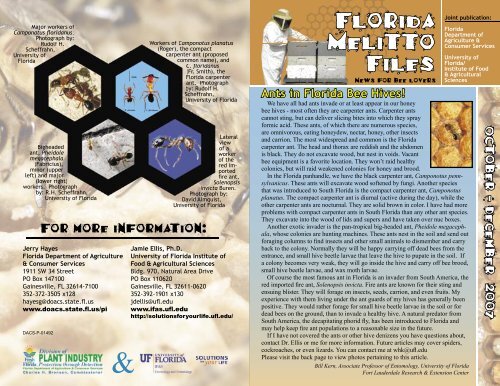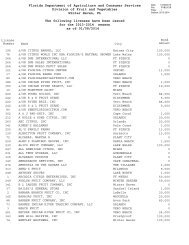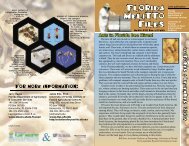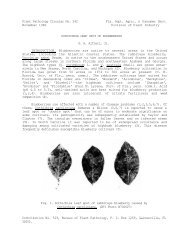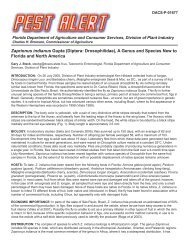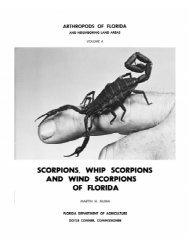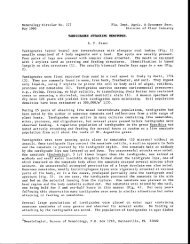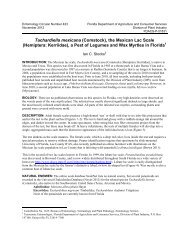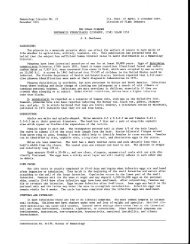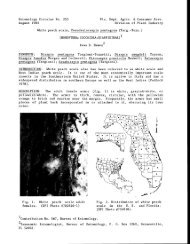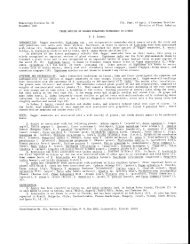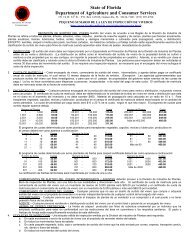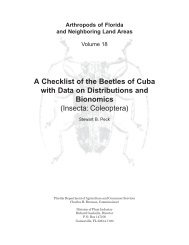Florida Melitto Files - Florida Department of Agriculture and ...
Florida Melitto Files - Florida Department of Agriculture and ...
Florida Melitto Files - Florida Department of Agriculture and ...
Create successful ePaper yourself
Turn your PDF publications into a flip-book with our unique Google optimized e-Paper software.
Major workers <strong>of</strong><br />
Camponatus fl oridanus.<br />
Photograph by:<br />
Rudolf H.<br />
Scheffrahn,<br />
University <strong>of</strong><br />
<strong>Florida</strong><br />
Bigheaded<br />
ant, Pheidole<br />
megacephala<br />
(Fabricius),<br />
minor (upper<br />
left) <strong>and</strong> major<br />
(lower right)<br />
workers. Photograph<br />
by: R.H. Scheffrahn,<br />
University <strong>of</strong> <strong>Florida</strong><br />
DACS-P-01492<br />
For more information:<br />
Jerry Hayes<br />
<strong>Florida</strong> <strong>Department</strong> <strong>of</strong> <strong>Agriculture</strong><br />
& Consumer Services<br />
1911 SW 34 Street<br />
PO Box 147100<br />
Gainesville, FL 32614-7100<br />
352-372-3505 x128<br />
hayesg@doacs.state.fl .us<br />
www.doacs.state.fl .us/pi<br />
&<br />
Workers <strong>of</strong> Camponotus planatus<br />
(Roger), the compact<br />
carpenter ant (proposed<br />
common name), <strong>and</strong><br />
C. fl oridanus<br />
(Fr. Smith), the<br />
<strong>Florida</strong> carpenter<br />
ant. Photograph<br />
by: Rudolf H.<br />
Scheffrahn,<br />
University <strong>of</strong> <strong>Florida</strong><br />
Lateral<br />
view<br />
<strong>of</strong> a<br />
worker<br />
<strong>of</strong> the<br />
red imported<br />
fi re ant,<br />
Solenopsis<br />
invicta Buren.<br />
Photograph by:<br />
David Almquist,<br />
University <strong>of</strong> <strong>Florida</strong><br />
Jamie Ellis, Ph.D.<br />
University <strong>of</strong> <strong>Florida</strong> Institute <strong>of</strong><br />
Food & Agricultural Sciences<br />
Bldg. 970, Natural Area Drive<br />
PO Box 110620<br />
Gainesville, FL 32611-0620<br />
352-392-1901 x130<br />
jdellis@ufl .edu<br />
www.ifas.ufl .edu<br />
http://solutionsforyourlife.ufl .edu/<br />
<strong>Florida</strong><br />
<strong>Melitto</strong><br />
<strong>Files</strong><br />
News for bee lovers<br />
Ants in <strong>Florida</strong> Bee Hives!<br />
Joint publication:<br />
<strong>Florida</strong><br />
<strong>Department</strong> <strong>of</strong><br />
<strong>Agriculture</strong> &<br />
Consumer Services<br />
University <strong>of</strong><br />
<strong>Florida</strong>/<br />
Institute <strong>of</strong> Food<br />
& Agricultural<br />
Sciences<br />
We have all had ants invade or at least appear in our honey<br />
bee hives - most <strong>of</strong>ten they are carpenter ants. Carpenter ants<br />
cannot sting, but can deliver slicing bites into which they spray<br />
formic acid. These ants, <strong>of</strong> which there are numerous species,<br />
are omnivorous, eating honeydew, nectar, honey, other insects<br />
<strong>and</strong> carrion. The most widespread <strong>and</strong> common is the <strong>Florida</strong><br />
carpenter ant. The head <strong>and</strong> thorax are reddish <strong>and</strong> the abdomen<br />
is black. They do not excavate wood, but nest in voids. Vacant<br />
bee equipment is a favorite location. They won’t raid healthy<br />
colonies, but will raid weakened colonies for honey <strong>and</strong> brood.<br />
In the <strong>Florida</strong> panh<strong>and</strong>le, we have the black carpenter ant, Camponotus pennsylvanicus.<br />
These ants will excavate wood s<strong>of</strong>tened by fungi. Another species<br />
that was introduced to South <strong>Florida</strong> is the compact carpenter ant, Camponotus<br />
planatus. The compact carpenter ant is diurnal (active during the day), while the<br />
other carpenter ants are nocturnal. They are solid brown in color. I have had more<br />
problems with compact carpenter ants in South <strong>Florida</strong> than any other ant species.<br />
They excavate into the wood <strong>of</strong> lids <strong>and</strong> supers <strong>and</strong> have taken over nuc boxes.<br />
Another exotic invader is the pan-tropical big-headed ant, Pheidole megacephala,<br />
whose colonies are hunting machines. These ants nest in the soil <strong>and</strong> send out<br />
foraging columns to fi nd insects <strong>and</strong> other small animals to dismember <strong>and</strong> carry<br />
back to the colony. Normally they will be happy carrying <strong>of</strong>f dead bees from the<br />
entrance, <strong>and</strong> small hive beetle larvae that leave the hive to pupate in the soil. If<br />
a colony becomes very weak, they will go inside the hive <strong>and</strong> carry <strong>of</strong>f bee brood,<br />
small hive beetle larvae, <strong>and</strong> wax moth larvae.<br />
Of course the most famous ant in <strong>Florida</strong> is an invader from South America, the<br />
red imported fi re ant, Solenopsis invicta. Fire ants are known for their sting <strong>and</strong><br />
ensuing blister. They will forage on insects, seeds, carrion, <strong>and</strong> even fruits. My<br />
experience with them living under the ant guards <strong>of</strong> my hives has generally been<br />
positive. They would rather forage for small hive beetle larvae in the soil or for<br />
dead bees on the ground, than to invade a healthy hive. A natural predator from<br />
South America, the decapitating phorid fl y, has been introduced to <strong>Florida</strong> <strong>and</strong><br />
may help keep fi re ant populations to a reasonable size in the future.<br />
If I have not covered the ants or other hive denizens you have questions about,<br />
contact Dr. Ellis or me for more information. Future articles may cover spiders,<br />
cockroaches, or even lizards. You can contact me at whk@ufl .edu<br />
Please visit the back page to view photos pertaining to this article.<br />
Bill Kern, Associate Pr<strong>of</strong>essor <strong>of</strong> Entomology, University <strong>of</strong> <strong>Florida</strong><br />
Fort Lauderdale Research & Extension Center<br />
October - December 2007
FDACS/DPI<br />
FROM THE DESK OF JERRY HAYES FROM THE DESK OF DR. JAMIE ELLIS<br />
In August, I represented the <strong>Florida</strong> <strong>Department</strong> <strong>of</strong><br />
<strong>Agriculture</strong> & Consumer Services, Division <strong>of</strong> Plant<br />
Industry’s apiary section at the North Central (NC) 508<br />
meeting titled, “Sustainable Solutions to Problems Affecting<br />
Honey Bee Health.” There were 25 attendees representing<br />
University Extension; USDA Cooperative State Research,<br />
Education, <strong>and</strong> Extension Service; American Association<br />
<strong>of</strong> Pr<strong>of</strong>essional Apiculturalist; <strong>and</strong>, Apiary Inspectors <strong>of</strong><br />
America. The meeting was designed to share, discuss <strong>and</strong><br />
formalize committee mechanisms for collaborative research<br />
Jerry Hayes, FDACS/DPI <strong>and</strong> funding possibilities to address honey bee health issues<br />
Asst. Chief Apiary Inspection <strong>and</strong> challenges.<br />
Public awareness has been suffi ciently raised, <strong>and</strong> the<br />
government’s attention is focused as at no other time on the devastating loss <strong>of</strong><br />
honey bees <strong>and</strong> other pollinators from the environment. Colony Collapse Disorder<br />
has been the riveting force for global recognition that honey bees are the vital link<br />
in production agriculture <strong>and</strong> the general health <strong>of</strong> the environment. Couple this<br />
raised awareness with the tremendous interest, support <strong>and</strong> political strength from<br />
other pollinator groups such as North American Pollinator Protection Campaign,<br />
Co-Evolution Institute, Monarch Watch, <strong>and</strong> the media, <strong>and</strong> you’ll see it has led to<br />
Congress stepping up to the plate to respond to the public’s dem<strong>and</strong> for a solution.<br />
There is a strong possibility that there will be funding made available through<br />
several pathways such as the Cooperative Agricultural Pest Survey, National<br />
Research Institute, 406 Programs, <strong>and</strong> others. The NC 508 group is preparing to<br />
access funding that becomes available to begin research in honey bee health.<br />
DPI, while not representing pure research or extension activities, was invited<br />
to participate in this meeting as a partner <strong>and</strong> part <strong>of</strong> this community. For any<br />
substantive research to be conducted, fi eld surveys will have to be performed.<br />
Beekeepers <strong>and</strong> apiaries will have to be identifi ed <strong>and</strong> located. Samples will have to<br />
be collected <strong>and</strong> assessments made. DPI’s apiary section was included in this seminal<br />
meeting in hopes that we would consider joining the collaborative effort if <strong>and</strong> when<br />
needed. Honey bee health <strong>and</strong> the health <strong>and</strong> vitality <strong>of</strong> our apiculture industry are<br />
the goals <strong>of</strong> all <strong>of</strong> us regardless <strong>of</strong> what “<strong>of</strong>fi cial” function we provide <strong>and</strong> who we<br />
serve. DPI was at the table, visible <strong>and</strong> willing to respond <strong>and</strong> be responsive within<br />
this community. We will have to see how this evolves, but I appreciate your support<br />
in extending the stride <strong>of</strong> DPI’s apiary section as we work with our colleagues in<br />
research <strong>and</strong> extension in other parts <strong>of</strong> the nation.<br />
The FDACS’ Division <strong>of</strong> Marketing, Bureau <strong>of</strong> Education <strong>and</strong> Communication<br />
has produced a high quality DVD, “Africanized Bees in <strong>Florida</strong>: Coping With The<br />
Challenge.” If you would like to share this video with your local media, please<br />
contact me by e-mail at hayesg@doacs.state.fl .us or phone me at (352) 372-3505 ext<br />
128 to request a copy.<br />
Greetings <strong>Florida</strong> Beekeepers! I hope that the summer<br />
beekeeping season treated you well <strong>and</strong> that your colonies<br />
are strong <strong>and</strong> healthy. My students, technicians, <strong>and</strong> I<br />
remain busy with our research, extension, <strong>and</strong> instruction<br />
efforts. I look forward to discussing our progress with you at<br />
the fall meeting <strong>of</strong> the <strong>Florida</strong> State Beekeepers Association<br />
(see special FSBA insert).<br />
I want to use this quarter’s column to give you a sneak<br />
preview <strong>of</strong> the <strong>Florida</strong> Master Beekeeper Program. Jerry<br />
Hayes (FDACS-DPI), Ray Zerba (extension agent, Clay<br />
Dr. Jamie Ellis<br />
County), Tom Donovan (extension agent, St. Johns County),<br />
UF Asst. Pr<strong>of</strong>essor<br />
Am<strong>and</strong>a Ellis (FDACS-DPI), Bill Kern (UF-IFAS), <strong>and</strong> I<br />
have met <strong>and</strong> designed what we believe to be the best Master Beekeeper Program<br />
<strong>of</strong>fered anywhere in the country. There is not enough space to discuss the program in<br />
detail here, but I plan to “unveil” the program in its entirety at the upcoming FSBA<br />
meeting in Winter Haven (you MUST attend this sure-to-be-great event!). Just to<br />
whet your appetite, I’ll give you a few <strong>of</strong> the highlights now.<br />
The <strong>Florida</strong> Master Beekeeper Program will be composed <strong>of</strong> 4 levels:<br />
Apprentice Beekeeper (participant has general knowledge <strong>of</strong> honey bees <strong>and</strong> beekeeping)<br />
Advanced Beekeeper (participant has advanced knowledge <strong>of</strong> beekeeping, honey bee<br />
biology, <strong>and</strong> other special topics)<br />
Master Beekeeper (participant chooses a “major” <strong>and</strong> demonstrates expertise in that major<br />
<strong>and</strong> in other specialized beekeeping topics)<br />
Master Craftsman Beekeeper (highest level in the program – the participant accrues public<br />
service credits, conducts a University-led research or extension project, <strong>and</strong> passes a series<br />
<strong>of</strong> challenging examinations)<br />
The program is designed to challenge beekeepers to become masters <strong>of</strong> their craft.<br />
The program usually takes 4+ years to complete. Achieving the Master Craftsman<br />
level is the non-academic equivalent to being awarded a masters degree in apiculture<br />
from any U.S. university. Although designed to train <strong>and</strong> challenge beekeepers, the<br />
program is also intended to facilitate the transfer <strong>of</strong> “bee-knowledge” to the general<br />
public through the efforts <strong>of</strong> program participants. I consider this a win-win.<br />
I realize that this is simply a snippet <strong>of</strong> information concerning the program.<br />
However, I plan to discuss the program in detail at the FSBA meeting in Winter<br />
Haven. Also, a website will be constructed for the program, <strong>and</strong> I hope to include the<br />
web address in the Jan – March issue <strong>of</strong> the <strong>Melitto</strong> <strong>Files</strong>. If you have questions<br />
about the program, contact me.<br />
I’ve got more good news - my colleagues <strong>and</strong> I are planning a University <strong>of</strong><br />
<strong>Florida</strong> Honey Bee College. Plans for this program are in the works. However, we<br />
intend to hold the event sometime in March <strong>of</strong> 2008. So begin making plans to attend<br />
this meeting now! The Master Beekeeper Program will <strong>of</strong>fi cially begin at the spring<br />
short course. The next issue <strong>of</strong> the <strong>Melitto</strong> <strong>Files</strong> will have more details. I hope<br />
that your fall beekeeping endeavors are fun <strong>and</strong> pr<strong>of</strong>i table.<br />
<strong>Florida</strong> <strong>Melitto</strong> <strong>Files</strong> ... News for Bee Lovers October - December 2007<br />
UF/IFAS
From David Westervelt<br />
Biological Scientist<br />
<strong>Florida</strong> <strong>Department</strong> <strong>of</strong> <strong>Agriculture</strong> <strong>and</strong> Consumer Services<br />
Division <strong>of</strong> Plant Industry<br />
Choosing the correct Terramycin® for Honeybees<br />
Which Terramycin® product is the correct one to use? It’s very simple,<br />
after talking to the pr<strong>of</strong>essionals at Pfizer Animal Health - THE LABEL IS<br />
THE LAW! Terramycin®, manufactured by Pfizer, is the registered name <strong>of</strong><br />
the product. The active ingredient, Oxytetracycline hydrochloride, is one <strong>of</strong><br />
the most widely used antibacterial drugs. Pfizer has two products registered<br />
for use on honeybees for treatment <strong>of</strong> American Foulbrood Paenibacillus<br />
larvae: Terramycin® Soluble Powder (TSB) <strong>and</strong> Terramycin-343® soluble<br />
powder. TSB is the preferred method used by beekeepers. Treatment requires<br />
a 6.4 oz package mixed with 2 lbs (32 oz) <strong>of</strong> powdered sugar; apply 2 tbs.<br />
over the top bars <strong>of</strong> each colony 3 times at 5-7 day intervals in the spring,<br />
<strong>and</strong> repeat in the fall. Terramycin-343® soluble powder is concentrated<br />
Terramycin®, <strong>and</strong> it is recommended to be mixed in syrup. Treatment<br />
requires a 4.78oz (135.5g) package mixed with 512 gallons <strong>of</strong> syrup. Prepare<br />
only the amount <strong>of</strong> mix that can be consumed by the bees in 24 hours. The<br />
active ingredient starts to break down as soon as it is mixed in syrup <strong>and</strong><br />
exposed to sunlight. Terramycin-343® is labeled for mixing with powered<br />
sugar, but it is not recommended due to the high concentration <strong>of</strong> the drug. It<br />
is hard to get the correct mixture in small quantities. In both treatments, the<br />
dosage is 200mg/colony administered in 3 applications at a 5-7day interval.<br />
Registered premixed treatments<br />
The following is a list <strong>of</strong> Terramycin® products that have been registered for<br />
use on bees for the treatment <strong>of</strong> American Foulbrood, <strong>and</strong> they do not require<br />
any mixing: Terra Brood Mix® (Mid-Con), Tetra Bee Mix® (Dadant), Terra<br />
Patties® (Mann Lake), <strong>and</strong> Terra Pro® (Mann Lake).<br />
CAUTION: Premixed treatments registered for use on other livestock are not<br />
legal for use on honeybees. They may contain ingredients that are harmful if<br />
consumed by honeybees.<br />
CAUTION: Use products as sole source <strong>of</strong> Oxytetracycline, <strong>and</strong> prepare<br />
fresh solutions every 24 hours. To avoid contamination <strong>of</strong> production honey,<br />
the drug should be fed to <strong>and</strong> consumed by the bees in early spring or fall, or<br />
removed six weeks before main honey flow begins.<br />
From Michael K. O’Malley<br />
Coordinator, African Bee Extension <strong>and</strong> Education Program<br />
University <strong>of</strong> <strong>Florida</strong><br />
Explaining African Bee Best Management Practices<br />
These African bee Best Management Practices (BMPs) aim to preserve<br />
public safety <strong>and</strong> protect the beekeeping industry from being liable for<br />
any AHB incidents. To help beekeepers underst<strong>and</strong> the importance <strong>and</strong><br />
reasoning behind them, BMPs are being featured in the <strong>Melitto</strong> <strong>Files</strong>.<br />
I discussed BMP points 1 <strong>and</strong> 2 in the last issue, <strong>and</strong> I continue with two<br />
more points below. A complete list <strong>of</strong> <strong>Florida</strong> BMPs is available by visiting<br />
on the web http://www.doacs.state.fl.us/pi/plantinsp/apiary/apiary.html.<br />
3 Honey bee colony divisions or splits should be queened with<br />
production queens or queen cells from EHB breeder queens following<br />
<strong>Florida</strong>’s Best Management Practices: The goal <strong>of</strong> requeening is to<br />
maintain manageable colonies that are not a threat to beekeepers or other<br />
members <strong>of</strong> the community. Therefore, it is vital that beekeepers ensure that<br />
any new queen introduced into a colony is <strong>of</strong> manageable European stock.<br />
New queens should be purchased from breeders; beekeepers are discouraged<br />
from allowing colonies to produce their own queens. Even if colonies<br />
are certified as EHB, the density <strong>of</strong> African bees in some areas <strong>of</strong> <strong>Florida</strong><br />
(particularly southern <strong>Florida</strong>) is such that if a virgin queen emerges, she has<br />
a high probability <strong>of</strong> mating with an AHB drone. To purchase a production<br />
queen, beekeepers should buy a queen from a <strong>Florida</strong> breeder that follows<br />
<strong>Florida</strong>’s BMPs for queen breeders (also available on the web at http://www.<br />
doacs.state.fl.us/pi/plantinsp/apiary/apiary.html), or buy a queen from a part<br />
<strong>of</strong> the country where AHBs have not permeated.<br />
4 <strong>Florida</strong> beekeepers are discouraged from collecting swarms that<br />
cannot be immediately re-queened from EHB queen producers: There<br />
is no way to tell the source <strong>of</strong> a swarm, <strong>and</strong> it may be AHB even if it does<br />
not immediately exhibit defensive behavior. The most common response<br />
by beekeepers to this point is that requeening a collected swarm with a<br />
European queen eliminates the potential for the swarm to cause problems.<br />
Yet, requeening a swarm is only half <strong>of</strong> the picture. When a beekeeper<br />
collects <strong>and</strong> attempts to “rehabilitate” a swarm by requeening it, they forget<br />
that the swarm also contains AHB drones. With the high queen turnover<br />
rate in managed colonies, a beekeeper can not afford to introduce AHB<br />
drones into his or her apiary. Finally, AHBs have a tendency to nest in open<br />
areas, so there could be comb being formed underneath what appears to be a<br />
swarm, meaning the colony is becoming established. If this is the case, any<br />
attempt to collect or disturb the bees may result in a stinging attack.<br />
<strong>Florida</strong> <strong>Melitto</strong> <strong>Files</strong> ... News for Bee Lovers October - December 2007
<strong>Florida</strong> Beekeeper Management Calendar – Fall 2007<br />
Month Management Calendar Blooming Plants<br />
North Oct – Dec 1) Varroa populations peaked in Aug/Sept. The Oct: Spanish Needle,<br />
<strong>Florida</strong><br />
economic threshold is 60+ mites/day on a sticky Mexican Clover<br />
Similar screen or 17+ mites in an ether roll for a colony <strong>of</strong><br />
Ensure manage- average strength. Treat if you exceed these<br />
that ment numbers. Options include: Apiguard, ApilifeVAR,<br />
colonies schemes Mite Away II<br />
have in Oct, 2) Can treat colonies for Nosema disease using<br />
enough Nov, <strong>and</strong> Fumigillin. Colonies may need as much as 4 gallons<br />
food. Dec. Pests <strong>of</strong> medicated syrup to control Nosema cerana<br />
It can become 3) Monitor for <strong>and</strong> control small hive beetles<br />
be cold less <strong>of</strong> a (options include Checkmite+, GardStar, Hood traps<br />
in N. problem <strong>and</strong> West Beetle traps)<br />
<strong>Florida</strong> late in 4) Feed colonies if light (colonies can starve!)<br />
during year. 5) Can treat for tracheal mites (mix vegetable oil <strong>and</strong><br />
winter.<br />
powdered sugar until doughy - not sticky to touch:<br />
place a pancake-sized patty on top bars <strong>of</strong> brood<br />
chamber)<br />
N ,<br />
Primrose Willow N ,<br />
Spotted Mint N , Golden<br />
Rod N , Vine Aster N ,<br />
Smart Weed N , Bush<br />
Aster ND<br />
Nov: nothing new<br />
blooms<br />
Dec: nothing new<br />
blooms<br />
Central Oct – Dec 1) Varroa populations peaked in Aug/Sept. The Oct: Spanish Needle,<br />
<strong>Florida</strong><br />
economic threshold is 60+ mites/day on a sticky Mexican Clover<br />
Similar screen or 17+ mites in an ether roll for a colony <strong>of</strong><br />
Varroa manage- average strength. Treat if you exceed these<br />
remain ment numbers. Options include: Apiguard, ApilifeVAR,<br />
an issue schemes Mite Away II<br />
through in Oct, 2) Can treat colonies for Nosema disease using<br />
winter Nov, <strong>and</strong> Fumigillin. Colonies may need as much as 4 gallons<br />
due to Dec. Pests <strong>of</strong> medicated syrup to control Nosema cerana<br />
warmer become 3) Monitor for <strong>and</strong> control small hive beetles<br />
temps. less <strong>of</strong> a (options include Checkmite+, GardStar, Hood traps<br />
problem <strong>and</strong> West Beetle traps)<br />
late in 4) Feed colonies if light (colonies can starve!)<br />
year. 5) Can treat for tracheal mites (mix vegetable oil <strong>and</strong><br />
powdered sugar until doughy - not sticky to touch:<br />
place a pancake-sized patty on top bars <strong>of</strong> brood<br />
chamber)<br />
N ,<br />
Primrose Willow N ,<br />
Spotted Mint N , Golden<br />
Rod N , Vine Aster N ,<br />
Smart Weed N , Bush<br />
Aster ND<br />
Nov: nothing new<br />
blooms<br />
Dec: nothing new<br />
blooms<br />
*<br />
Brazilian Pepper blooms<br />
from September through<br />
October <strong>and</strong> is a<br />
significant fall source <strong>of</strong><br />
nectar for bees.<br />
South Oct – Dec 1) Varroa populations peaked in Aug/Sept. The Oct: Spanish Needle<br />
<strong>Florida</strong><br />
economic threshold is 60+ mites/day on a sticky<br />
Similar screen or 17+ mites in an ether roll for a colony <strong>of</strong><br />
Varroa manage- average strength. Treat if you exceed these<br />
are an ment numbers. Options include: Apiguard, ApilifeVAR,<br />
important schemes Mite Away II<br />
issue in in Oct, 2) Can treat colonies for Nosema disease using<br />
S. <strong>Florida</strong> Nov, <strong>and</strong> Fumigillin. Colonies may need as much as 4 gallons<br />
in winter Dec. Pests <strong>of</strong> medicated syrup to control Nosema cerana<br />
because become 3) Monitor for <strong>and</strong> control small hive beetles<br />
colonies less <strong>of</strong> a (options include Checkmite+, GardStar, Hood traps<br />
rarely are problem <strong>and</strong> West Beetle traps)<br />
broodless. late in 4) Feed colonies if light (colonies can starve!)<br />
year. 5) Can treat for tracheal mites (mix vegetable oil <strong>and</strong><br />
powdered sugar until doughy- not sticky to touch:<br />
place a pancake-sized patty on top bars <strong>of</strong> brood<br />
chamber)<br />
ND ,<br />
Mexican Clover ND ,<br />
Primrose Willow ND ,<br />
Smart Weed,<br />
Melaleuca ND ,<br />
Nov: nothing new<br />
blooms<br />
Dec: Maple, Willow<br />
*<br />
Brazilian Pepper blooms<br />
from September through<br />
October <strong>and</strong> is a<br />
significant fall source <strong>of</strong><br />
nectar for bees.<br />
N D ND<br />
Continues to bloom in Nov, Continues to bloom in Dec, Continues to bloom in Nov <strong>and</strong> Dec


